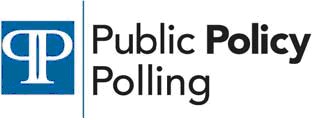Tennessee was a rare state where Barack Obama performed worse in 2008 than John Kerry did in 2004, albeit by less than one point on the margin. But the state now joins red-turned-blue neighbors North Carolina and Virginia as states where Obama has actually improved since the last election. While he lost to John McCain by 15 points last time, he now trails next year's crop of Republican frontrunners by no more than 12.
Neighboring Arkansas' Mike Huckabee typically does best against the president in Southern states, and he comes closest to matching McCain's margin of victory here, 53-41. The other candidate who usually runs closest to Obama, Mitt Romney, beats him here, 48-41. But neighboring Georgia's Newt Gingrich can manage only a 46-43 lead, and Sarah Palin actually ties the president at 45%.
President Obama's 42-52 approval rating puts his standing here near the bottom third of the 42 states in which PPP has measured him in the last year. But except Huckabee, none of the Republicans is seen a whole lot better. The former Arkansas governor has a pretty outstanding 50-29 favorability margin because he's liked the best by Democrats (-28), independents (+27), and Republicans (+65) alike. All the others are seen negatively by independents. Indeed, among all voters, Romney stands at 33-41, Palin at 39-51, and for once, Gingrich bringing up the rear instead of Palin, 30-49.
Not surprisingly then, Huckabee is the only candidate who soundly beats the president with independents, 51-40, similar to the president's 41-50 disapproval mark with them. Romney manages an inconsequential 43-42 lead, but against Gingrich, Obama wins unaffiliated voters' support, 43-35, and he prevails 49-38 against Palin.
The secret to these candidates maintaining at least a tie against the president is that all four of them capitalize on the 43-37 Republican turnout advantage by pulling more Democratic voters from Obama than he does Republicans from them. Palin and Gingrich only barely do so, hence their razor-thin horserace results. But Huckabee takes 13% and Romney 12% of Obama's partisans while each losing only 4% the other way. This is not an unusual trend for Southern states, where many Democrats are still registered as such but vote Republican for president and, increasingly, other races as well.
Also, while a good chunk of Republicans are on the fence about whether to support Palin, Romney, or Gingrich, Huckabee locks up 90% of the GOP versus the others' 80-84%. Obama himself maintains 83-88% of Democrats' votes, and few Democrats are undecided.
Tennessee adds another state to the list that could turn interesting if Sarah Palin wins the nomination, but otherwise, or even if she is crowned next summer, the state ought to remain red.
Full results here.
Thursday, February 17, 2011
Subscribe to:
Post Comments (Atom)



2 comments:
I find it interesting that Obama tends to do slightly better than expected in many red regions (the South, mainly - TN,SC,etc.) and slightly worse than expected in blue regions (e.g. MA.) Perhaps it's a sign that the polarization of our nation is diminishing... or merely that the bases have not consolidated around their candidates completely yet.
Anonymous, I think more likely it's because Obama has rallied the black population (who are mostly Democrats) in those states like no other candidate before him ever has.
Post a Comment